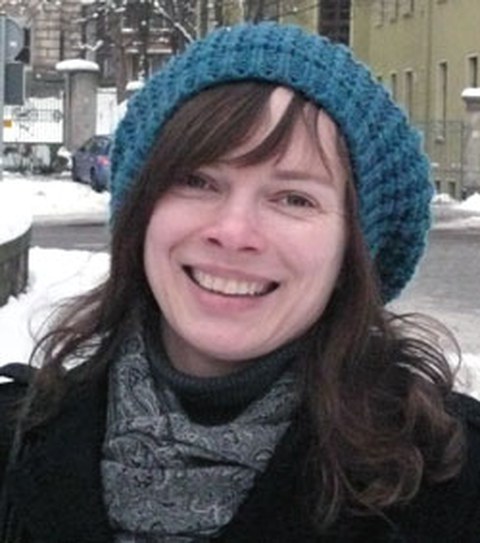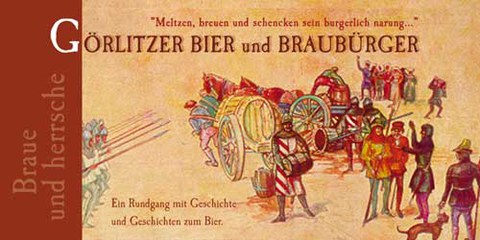Archives and guided tours
(Interview from 2010)
Dagmar Möbius
Research is not dry. Archives even less so. The art historian Katja Lindenau used to dream of working in a museum. Then she did a doctorate on beer and brewing. The topic was a coincidence. But today, she does sometimes let people experience the results of her research. She also does research for bodies including the Staatliche Kunstsammlungen Dresden state art collections.

Dr. Katja Lindenau
She knew she wanted to study. But languages or teaching? "The main thing is not to be too far from home," thought Dr. Katja Lindenau, who is from Erlabrunn. After graduating from high school, she decided on art history, history, and Romance studies. After a successful interview in the summer of 1994, Katja Lindenau started her degree at TU Dresden. "Leipzig would also have been an option, but in Dresden, the city of art and culture, the prospect of earning my keep with my chosen 'unprofitable' subjects seemed better," laughs the 33-year-old.
For her, art was less about practical, artistic ambitions and more about perspective and considered observation, and (historical) contextualization. Her interest in the past and the continuing impact of history in the present day led her to choose a minor in medieval history. A semester abroad at the University of Bologna gave Katja Lindenau the language practice that had until then been neglected. When she talks about her time at university, her eyes light up. "You could feel the professors' personal enthusiasm for their subject." And not just on study trips. She found the broad overview of art history provided by the lecturers' different areas of specialization very valuable. Then there were the relatively small seminar groups, in which students prepared, gave and discussed presentations. "The professors had the time to personally evaluate assignments; this was particularly true for my history course," Katja Lindenau says. The introduction to using archives and libraries for finding with sources that she got at university still helps her in her research today. "Working as a student assistant at the Institute of Art History's slide library trained my eye for art history, and familiarized me with aspects of the (over)abundance of images in various media, the storage of information, and questions of copyright," she adds.
Her work from 2001 to 2005 in TU Dresden Collaborative Research Center 537 "Institutionality and Historicity" on the early modern history project "The Institutional Order of Public Spaces" with Prof. Dr. Gerd Schwerhoff led her to her doctoral thesis: "Brew and rule. The Görlitz brewers as an urban elite in the late Middle Ages and early modern period" ("Brauen und herrschen. Die Görlitzer Braubürger als städtische Elite in Spätmittelalter und Früher Neuzeit"). The topic came about largely by chance. "We were looking at public spaces in the early modern period, and they included inns as well as town halls, churches, and markets," explains the historian, who hardly ever drinks beer herself.
Katja Lindenau founded "Büro für kunst:historische Beratung" in Dresden after earning her doctorate in 2006. As a freelancer, she is now involved in various research projects. These have included work for the Galerie Neue Meister, the Städtische Galerie Dresden, and the Sächsische Landesstelle für Museumswesen regional museums office. She is currently researching for a project on provenance at the Staatliche Kunstsammlungen Dresden and is working on preparations for the Third Saxon State Exhibition, VIA regia.
"You can research a lot of areas, but most of that research never reaches the public," she says, explaining her idea of developing a themed guided tour all about Görlitz's brewing industry. The tour is extremely popular and runs around once a month from spring to fall. "I owe my active, creative and often joyful and sociable view of art and history to the study trips I went on during my degree," Katja Lindenau firmly believes. Her groups particularly appreciate the fact that she herself has seen and engaged with the places, events, and material she is telling them about. Alongside guided tours of Görlitz, Katja Lindenau also runs guided tours of the artists' collective "Die Brücke" in Dresden and Moritzburg.
Her ties with TU Dresden have never been broken. Since 2006, Dr. phil. Katja Lindenau has lectured on the art and design minor on the media informatics program at the Faculty of Computer Science, a collaboration between the Institute of Art History and the Chair of Operating Systems (Prof. Hermann Härtig). "It is exciting not only to share my knowledge of art history and methodology, but also to learn myself about new technical possibilities in the design of websites, programs, and presentations," she says happily.
She has ongoing contact with many of her former fellow students. "My fellow students are now my colleagues – it's great that things have worked out this way." That is another reason why she feels at home in Dresden. Katja Lindenau is not disappointed that she never did get a permanent post at a museum. "I enjoy my work," she tells us. Nevertheless, being part of a team in charge of a museum exhibition would still appeal to her, to experience the meaning of art in context.
Contact details:
Büro für kunst::historische Beratung
Dr. phil. Katja Lindenau
Tieckstr. 4
01099 Dresden
0172-7955790
Email: Katja Lindenau
Web: Kunst-Geschichten

